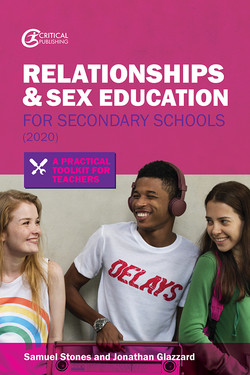Читать книгу Relationships and Sex Education for Secondary Schools (2020) - Samuel Stones - Страница 11
ОглавлениеCHAPTER OBJECTIVES
After reading this chapter you will understand:
the characteristics of healthy relationships;
how to teach students about consent;
a range of common stereotypes that students should be taught to recognise;
the importance of teaching students about bullying and unacceptable behaviour within relationships;
the need to support students to understand the purpose of the Equality Act (2010) and the range of protected characteristics.
INTRODUCTION
This chapter outlines some of the characteristics of healthy relationships and it highlights the common challenges that students often experience in relation to friendships. It emphasises the role of parental and peer influence within the context of adolescence and some guidance is offered to support you to teach students about consent. Some case study material is provided to illuminate effective practice in relation to the teaching of consent and critical questions are asked to encourage your reflection. The chapter also provides some discussion in relation to stereotyping to support you to teach students about this concept. Some common types of stereotyping have been stated. The roles and responsibilities of schools are explained in relation to teaching students to understand different types of bullying and some examples are offered to support your understanding of what constitutes bullying and how it can take place. The implications of equality legislation are also outlined, and the chapter emphasises your role in relation to teaching students to recognise these and understand the purpose of equality legislation.
HEALTHY RELATIONSHIPS
Healthy relationships, including friendships, are characterised by trust, respect, honesty, kindness, generosity, boundaries, privacy, consent, conflict management and reconciliation. Adolescence can be a difficult time. It is a stage within the life cycle when many young people are exploring their identities and developing their interests, aspirations, values and beliefs. It is common during this stage for friendships to be dissolved and for new friendships to be established. It is also a time when young people seek greater independence from their parents. Consequently, peer influence can be greater than parental influence during this stage of development. Adolescence can be a time when young people start to take risks and, for many, it is a time for developing personal and intimate relationships and therefore a time for sexual experimentation. Taking all of these things into account, adolescence can be a time when friendships and family relationships are tested to their limits.
CONSENT
Consent is often understood within the context of sexual relationships. However, consent should underpin all healthy relationships, including friendships. A clear definition of consent is provided below:
Consent is agreement which is given willingly and freely without exploitation, threat or fear, and by a person who has the capacity to give their agreement.
(PSHE Association, 2015, p 6)
A person consents to something if they agree by choice, and if they possess the freedom and capacity to make that choice. The concept of sexual consent is addressed in Chapter 7. Consent is underpinned by some key principles. These are outlined below.
It is the person seeking consent who is responsible (ethically and legally) for ensuring that consent is given by another person, and for ensuring that that person has the freedom and capacity to give their consent.
If consent is not clear, informed, willing and active, it must be assumed that consent has not been given. If consent is not clearly given, or is given and then subsequently retracted, this decision must always be respected. Since people can change their minds, or consent to one thing but not to something else, the seeker of consent must keep assessing whether consent is clear, informed, willing and active. Consent must be seen as an ongoing process, not a ‘one-off’.
In healthy relationships, both parties respectfully seek each other’s consent and know that their decision to give or not give consent will be respected. A person is never to blame if their decision not to give consent or to withdraw consent is not respected.
(PSHE Association, 2015, p 3)
